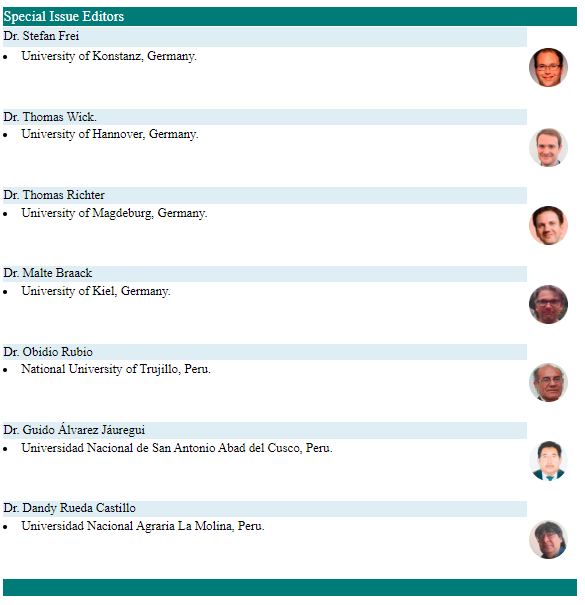Mathematical analysis of a symptom-structured epidemic model
DOI:
https://doi.org/10.17268/sel.mat.2021.02.07Palavras-chave:
vaccination, stability, sensitivity, COVID-19Resumo
We propose a modification of the SLIAR (Susceptible- Latent-Symptomatic Infected- Asymptomatic- Recovered) mathematical-epidemiological model with vital dynamics. This model includes a vaccination control strategy, and a treatment to reduce the symptoms, also the symptomatic infected population is divided into two states according to its severity. The qualitative analysis shows the local stability of the disease-free equilibrium point and the endemic point. Simulations and the statistical sensitivity analysis are developed using a set of parameters for COVID-19, and we found that the transmission, recruitment, finally, vaccination rates are potential targets to control an outbreak.
Referências
Abrams S, Wambua J, Santermans E, Willem L, Kuylen E, Coletti P, et al. Modelling the early phase of the Belgian COVID-19 epidemic using a stochastic compartmental model and studying its implied future trajectories. Epidemics. 2021;35(100449):100449.
Aguilar JB, Faust JS, Westafer LM, Gutierrez JB, Investigating the impact of asymptomatic carriers on COVID-19 transmission, medRxiv (preprint) (2020).
Amaya-Muvdi DA, Acercamientos a la epidemología de una enfermedad a través de sistemas compartimentales,B.S. thesis, Bogotá-Universidad de Los Andes, 2015.
Arino J, Brauer F, van den Driessche P, Watmough J, Wu J. Simple models for containment of a pandemic. J R Soc Interface. 2006;3(8):453–7.
Arino J, Brauer F, van den Driessche P, Watmough J, Wu J. A final size relation for epidemic models. Math Biosci Eng. 2007;4(2):159–75.
Arino J, Portet S. A simple model for COVID-19. Infect Dis Model. 2020;5:309–15.
Arino J. Mathematical epidemiology in a data-rich world. Infect Dis Model. 2020;5:161–88.
Brauer F. Some simple epidemic models. Math Biosci Eng. 2006;3(1):1–15.
Castillo-Salgado C, Mujica Ó J, Loyola E, Canela J ,Módulos de principios de epidemiología para el control de enfermedades, segunda edición. Organización Panamericana de la Salud. Washington D.C., 2011.
Chen J. Pathogenicity and transmissibility of 2019-nCoV-A quick overview and comparison with other emerging viruses. Microbes Infect. 2020;22(2):69–71.
Diekmann O, Heesterbeek JAP, Roberts MG. The construction of next-generation matrices for compartmental epidemic models. J R Soc Interface. 2010;7(47):873–85.
Kim S, Seo YB, Jung E. Prediction of COVID-19 transmission dynamics using a mathematical model considering behavior changes in Korea. Epidemiol Health. 2020;42:e2020026.
Kermack WO, McKendrick AG. A contribution to the mathematical theory of epidemics. Proc R Soc Lond A Math Phys Sci. 1927;115(772):700–21.
Lai C-C, Shih T-P, Ko W-C, Tang H-J, Hsueh P-R. Severe acute respiratory syndrome coronavirus 2 (SARS-CoV-2) and coronavirus disease-2019 (COVID-19): The epidemic and the challenges. Int J Antimicrob Agents. 2020;55(3):105924.
Lauer SA, Grantz KH, Bi Q, Jones FK, Zheng Q, Meredith HR, et al. The incubation period of Coronavirus disease 2019 (COVID-19) from publicly reported confirmed cases: Estimation and application. Ann Intern Med. 2020;172(9):577–82.
Li R, Pei S, Chen B, Song Y, Zhang T, Yang W, et al. Substantial undocumented infection facilitates the rapid dissemination of novel coronavirus (SARS-CoV-2). Science. 2020;368(6490):489–93.
Liu Y, Gayle AA,Wilder-Smith A, Rockl¨ov J. The reproductive number of COVID-19 is higher compared to SARS coronavirus. J Travel Med. 2020;27(2). Available from: http://dx.doi.org/10.1093/jtm/taaa021.
Longini IM Jr, Halloran ME, Nizam A, Yang Y. Containing pandemic influenza with antiviral agents. Am J Epidemiol. 2004;159(7):623–33.
Marino S, Hogue IB, Ray CJ, Kirschner DE. A methodology for performing global uncertainty and sensitivity analysis in systems biology. J Theor Biol. 2008;254(1):178–96.
MINSA, Resolución Ministerial-139-2020-MINSA: Documento Técnico - Prevención y atención de personas afectadas por COVID-19 en el Perú,(MINSA) (2020) 6-9.
MINSA, Sala situacional COVID-19 Perú, updated to 28/09/2020 [Reviewed 29/09/2020],Ministerio de Salud de la República del Perú (MINSA). Available from: https://covid19.minsa.gob.pe/sala_situacional.asp.
Rasmussen AL, Popescu SV. SARS-CoV-2 transmission without symptoms. Science. 2021;371(6535):1206–7.
Romero-Brufau S, Chopra A, Ryu AJ, Gel E, Raskar R, Kremers W, et al. Public health impact of delaying second dose of BNT162b2 or mRNA-1273 covid-19 vaccine: simulation agent based modeling study. BMJ. 2021;373:n1087.
Tang B, Wang X, Li Q, Bragazzi NL, Tang S, Xiao Y, et al. Estimation of the transmission risk of the 2019-nCoV and its implication for public health interventions. J Clin Med. 2020;9(2):462.
van den Driessche P, Watmough J. Reproduction numbers and sub-threshold endemic equilibria for compartmental models of disease transmission. Math Biosci. 2002;180(1–2):29–48.
Wintachai P, Prathom K. Stability analysis of SEIR model related to efficiency of vaccines for COVID-19 situation. Heliyon. 2021;7(4): e06812.
Yang CY, Wang J. A mathematical model for the novel coronavirus epidemic in Wuhan, China. Math Biosci Eng. 2020;17(3):2708–24.
Yang CY, Wang J. Modeling the transmission of COVID-19 in the US–A case study. Infectious Disease Modelling 2021; 6:195-211.
Zhang T, Liu J, Teng Z. Existence of positive periodic solutions of an SEIR model with periodic coefficients. Appl Math (Prague). 2012;57(6):601–16.
Zhou F, Yu T, Du R, Fan G, Liu Y, Liu Z, et al. Clinical course and risk factors for mortality of adult inpatients with COVID-19 in Wuhan, China: a retrospective cohort study. Lancet. 2020;395(10229):1054–62.
Downloads
Publicado
Como Citar
Edição
Seção
Licença
Copyright (c) 2021 Selecciones Matemáticas

Este trabalho está licenciado sob uma licença Creative Commons Attribution 4.0 International License.
Os autores que publicam nesta revista aceitam as seguintes condições:
Os autores mantêm os direitos autorais e atribuem à revista o direito da primeira publicação, com o trabalho registrado com a licença de atribuição Creative Commons Atribución 4.0 Internacional (CC BY 4.0), que permite que terceiros usem o material publicado sempre que mencionarem a autoria do trabalho e os direitos autorais. Primeira publicação nesta revista.
Os autores podem fazer outros acordos contratuais independentes e adicionais para a distribuição não exclusiva da versão do artigo publicada nesta revista (por exemplo, incluí-la em um repositório institucional ou publicá-la em um livro), desde que afirme claramente que o trabalho Foi publicado nesta revista.
É permitido e recomendado aos autores que publiquem seus trabalhos na Internet (por exemplo, em páginas institucionais ou pessoais) antes e durante o processo de revisão e publicação, pois isso pode levar a trocas produtivas e a uma disseminação maior e mais rápida do trabalho. publicado (Consultar: efeito do acesso aberto).












